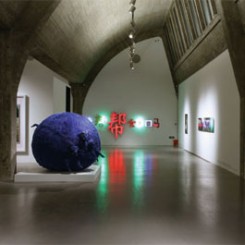“‘To Raise the Water Level of a Fish Pond’ (1997), included here, is possibly Zhang Huan’s most widely known and credited works abroad, but the body of earlier works beginning in 1993 is essential to any map of the history of performance art in China: if these were not ‘great performances,’ then how should a great performance be adjudged?”
Perhaps performance art is gaining ground in general—hence Performa as part of the 2010 Shanghai Biennale. It was also this year that, in conjunction with an exhibition of works from the Domus Collection at UCCA in 798, Beijing art audiences were able to experience the very latest in “cutting-edge” performance from the Chinese-Canadian artist Terence Koh. UCCA also offered the mother of monumental performances—if ever there was a performance it was surely this—in “Hope Tunnel,” Zhang Huan’s rescue of a train buried in Sichuan earthquake. Zhang Huan is, of course, one of China’s leading performance artists, its most infamous even, and is, too, represented by Pace. Thus, he was surely under-represented in the work included in Great Performances: there was no mention of “Hope Tunnel.” “To Raise the Water Level of a Fish Pond” (1997), included here, is possibly Zhang Huan’s most widely known and credited works abroad, but the body of earlier works beginning in 1993 is essential to any map of the history of performance art in China: if these were not “great performances,” then how should a great performance be adjudged? In a historic sense, the works of other artists, like Ma Liuming, Wang Jin, Yang Zhichao, Zhu Fadong, Zhang Dali, Zhao Bandi and Sun Yuan & Peng Yu, were more representative: a photograph of “Fen-Ma Liuming” in female costume from 1993; one image from the triptych “Red Flag Canal” (1994), showing the artist dying a river red with “brick dust”; images of “Planting Grass” in the artist’s shoulder, 2000; photos of this “Artist for Sale” (1995); a single image of Zhang Dali’s infamous graffiti tag from the “Demolish” series; a selection of the info-posters featuring “Bandi”; and a video of “Dogs which cannot touch each other” (2003). Each of these interventions has a place in history, and many fed off each other as well as the circumstances of the society and the art scene they were intended to defy or, arguably, to defile. Qin Ga’s “Miniature Long March” has resonance here, as does Ma Qiusha’s performance “From 4 Pingyuanli to 4 Tianqiao beili,” although as artists they, like Lin Yilin, are perhaps as yet less well known to general audiences.
